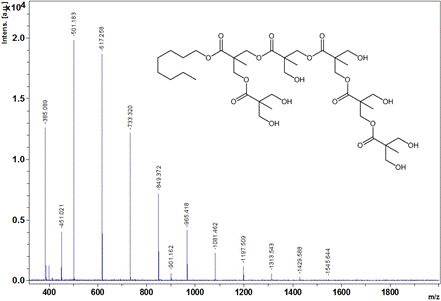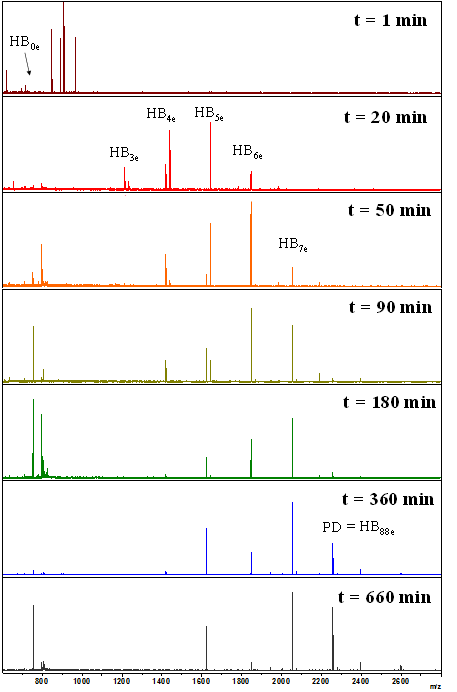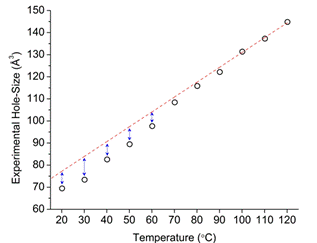Reports: ND753980-ND7: The Modular Synthesis and Fundamental Properties of Hyperbranched Polymers Based on bis-MPA Monomers: Comparison with Dendrimers and Linear Analogs
Scott M. Grayson, Tulane University
I. Project Goal: The overarching aim of this proposal is to determine how branching effects the physical properties of hyperbranched polymers. Although hyperbranched polymers have been studied in tremendous detail, they have never been compared side-by side with exact linear and dendrimer analogs. The bis-MPA monomer is one of the most important for commercial applications of hyperbranched polymers, and therefore we are setting out to develop the synthesis of exact dendrimers, linear polymers, and pseudodendrimers.
II. Synthetic Research Progress:
2a) Synthesis of a protected linear monomer: In order to access a wider variety of linear and hyperbranched analogs of bis-MPA, the synthesis of the linear monomer had to be optimized and scaled up. The following synthetic route makes use of a silver oxide catalyst for the selective monobenzylation and has been optimized and scaled-up in multi-gram batches (Figure 1).
Figure 1: Multiple synthetic routes attempted to yield linear bis-MPA monomer
2b) Hyperbranched Analogs: While the synthesis of hyperbranched bis-MPA polymers has been well-established, the proposed kinetic studies require that the hyperbranched polymers be grown from specific cores so that they may be mixed with dendrons, and their reactions be monitored in tandem (the identities of the products being ascertained by unique mass labels). After initial tests, an octanol core was determined to be the idea target. The purity of the octanol-initiated HBPs is confirmed by MALDI-TOF MS (figure 2).
Figure 2: Hyperbranched bis-MPA generated by initiation from octanol core. MALDI-TOF MS confirms the mass distribution and the structural regularity of the hyperbranched sample
2c) Kinetic Studies: The esterification reaction utilized to prepare dendrimers and pseudodendrimers is one examples of a reaction that can be monitored by MALDI-TOF MS to quantify the kinetics for each esterification (figure 3). In a specific example of such an MS kinetic study, a HBP 7-mer was isolated by column chromatography and reacted with an excess of esterification reagent (8 esterifications results in the generation of a “pseudodendrimer”). It is noteworthy that in the initial 20 minutes, the HBP sample exhibited fast reactivity of the first 4-5 hydroxyl groups. However, only after an addition 200-400 minutes is the pseudodendrimer (a full 8 esterifications) observed in appreciable concentrations. This provides additional data to support early NMR data that the first reactions on a terminal bis-MPA unit reacts rapidly, but the second one is hindered by the size of the adjacent ester.
Figure 3: MALDI-TOF MS kinetic study of the esterification of HBP 7-mer with dendronizing monomer.
2d) Dendrimer Analogs: The bis-MPA dendrimers have already been reported by others, and there synthesis has been scaled up, so as to provide material for physical studies.
III. Characterization Research Progress:
One of the focuses of the effort at USM is to investigate the role of linear units in hydrogen bond organization and structural order exhibited by bis-MPA based HBPs. A distinct feature of the HBP structure is the inclusion of linear units (unfulfilled branching points) which result in hydroxyl end-groups throughout the structure, as opposed to solely at the periphery as observed with dendrimers.
Figure 4. Synchrotron X-ray scattering patterns for Boltorn TM H20 between 25-130°C. Curves were shifted vertically for clarity. Mechanism of the mesophase formation leads to narrow, temperature dependent peak at q = 15.7o.
The linear sequences which exist in the structure of bis-MPA based HBPs have been linked in the past to a hydrogen bond (HB)-mediated structural ordering phenomenon which reveals itself on the X-ray scattering pattern in the form of a narrowing the amorphous halo peak 2θ ≈ 17° (l = 1.542Å). Despite previous efforts, specific details on the structural origin of this amorphous halo narrowing and related structural ordering phenomenon have not been yet fully elucidated. Two-dimensional (2D) temperature-dependent WAXS experiments which we recently performed at the synchrotron X-ray beamline X27C at National Synchrotron Light Source (NSLS), Brookhaven National Laboratory (BNL). (l = 1.371Å) in conjunction with DSC experiments helped to understand this phenomenon in greater detail. In these experiments we used BoltornTM HBPs. Higher resolution synchrotron X-ray patterns conducted over a wide temperature-range revealed a narrow, temperature depended peak with the maximum at 2θ ≈ 15.7° which coincided with broader amorphous halo peak with the maximum at 2θ ≈ 15.0° (Figure 4). The discovered narrow peak we attributed to the liquid crystalline like mesophase consisting of laterally attached H-bonded linear chain segments. Apparently, this mesophase exhibited cylindrical symmetry and hexagonal structural order but in contrast to true polymer crystals there was a lack of conformational order within H-bonded linear chain segments. Similar H-bond facilitated ‘pseudo-hexagonal’ mesophase has been reported to exist also in nylon-6.
Figure 5. Hole size volume determined by PALS for H20 HBP.
Interestingly, we probed the free-volume of BoltornTM HBPs by Positron Annihilation Life-Time Spectroscopy (PALS). The molecular hole-size versus temperature data are shown in Figure 5 and support WAXS and DSC results. If there was no H-bonded mesophase formation, then the slope of vh-T would be linear. Above ~100°C, the mesophase completely melts out and the bulk is completely amorphous. Between 20-60°C the experimentally observed hole-sizes are smaller than the extrapolated ones indicative of the formation of this liquid-crystalline like mesophase in this temperature range.
IV. Research Impact: Although bis-MPA hyperbranched polymers have already been the subject of numerous physical studies, the synergy described in this project between modern characterizational tools (e.g. MALDI-TOF MS, WAXS and PALS) in addition to more traditional tools offers insight into the fundamental nature of branching in polyester. Because of the unprecedentedly large architectural library being studies, these investigations are expected to also provide broad insight into the fundamental role of architecture in polymer structure-property relationships.
V. Impact on Researchers and Collaboration: The generous funding by the ACS-PRF has enabled these new collaborators to establish sufficient groundwork to generate a number of manuscripts (in preparation) as well as provide sufficient preliminary results to write competitive proposals. Perhaps most importantly, it has provided graduate students a unique opportunity to collaborate across traditional disciplines to better understand the interdisciplinary nature of polymer science.
















